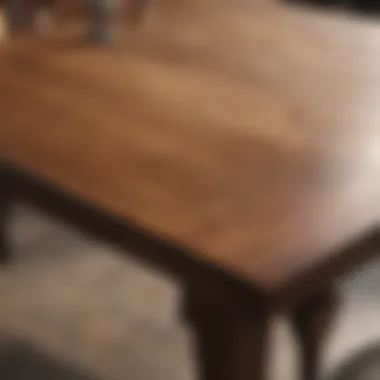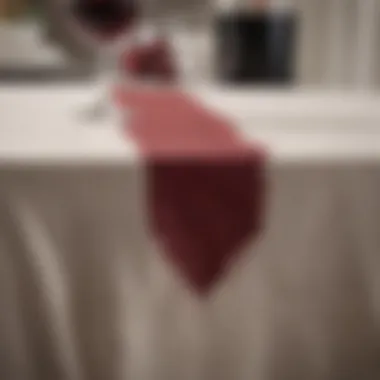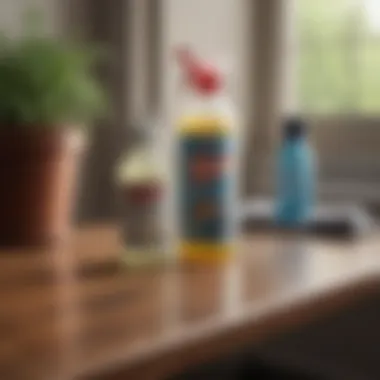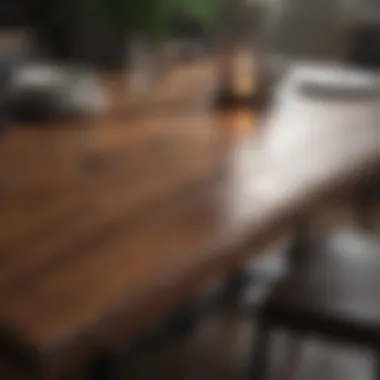Comprehensive Guide on How to Remove Table Stains


Intro
Table stains can be a significant concern for homeowners and interior design enthusiasts alike. The surface of a table often reflects the overall aesthetics of a space, making it crucial to maintain its beauty and functionality. Various materials, such as wood, glass, and metal, each handle stains differently. Hence, knowing how to manage and prevent these blemishes is essential for preserving the quality and appearance of your dining surfaces.
This guide aims to provide you with a thorough understanding of how to effectively remove stains from tables. We will explore the types of stains that can occur, the appropriate methods for different materials, and preventative measures to mitigate future issues. By the end, you will have reliable techniques at your disposal to keep your tables looking pristine.
Understanding Table Stains
Understanding table stains is essential for maintaining the aesthetic appeal and longevity of dining surfaces. Stains, if left untreated, can compromise not only the visual aspect of the table but also its structural integrity. By identifying the type of stain early, you can select the most suitable removal method, thereby reducing permanent damage. This section outlines various types of stains and common table materials, laying a solid foundation for effective stain removal strategies.
Types of Stains
Food and Beverage Stains
Food and beverage stains are among the most common stains found on tables, resulting from spills of items like wine, coffee, or sauce. One key characteristic of food and beverage stains is their chemical composition, often containing sugars, acids, or pigments that can lead to discoloration. These stains are particularly relevant as they represent everyday occurrences in dining situations. The unique feature of food and beverage stains is their potential to be removable with immediate action; the sooner you address the stain, the easier it is to clean. However, failure to act quickly may allow these stains to set, complicating the removal process.
Oil-based Stains
Oil-based stains come from substances such as cooking oils, salad dressings, or grease from food. One important aspect of oil-based stains is that they are often tougher to remove than other types of stains. This is due to their hydrophobic nature, which causes them to resist water-based cleaning methods. Oil-based stains have a notorious reputation for being persistent, making proper identification crucial. Using the right cleaning agents, like baking soda, can sometimes lead to satisfactory removal results. Nevertheless, caution is necessary as aggressive cleaning methods may damage the table's surface.
Ink and Dye Stains
Ink and dye stains can occur from pens, markers, or dye transfers from clothing. These stains are characterized by their intense pigmentation, making them visually striking yet challenging to remove. A significant aspect of ink and dye stains is the risk they present for permanent damage, particularly if they dry or set. However, their removal can often be effective if addressed swiftly with solvents such as rubbing alcohol. The effectiveness of removal largely depends on the material of the table and the ink's composition, thus requiring careful consideration when choosing a cleaning method.
Water Marks
Water marks are typically the result of moisture exposure, commonly seen on wooden surfaces. A notable feature of water marks is that they appear as cloudy spots, often created when moisture penetrates the finish of the wood. These marks are especially prevalent in humid environments or where water glasses are frequently placed. The good news is that water marks may be removable with simple techniques, such as the application of heat from an iron or the use of furniture polish. However, if the finish itself is damaged, this may not suffice, and professional intervention might become necessary.
Common Table Materials
Wood
Wood is a classic choice for tables due to its warmth and aesthetic appeal. However, wood surfaces are particularly susceptible to stains, scratches, and moisture damage. One of the key characteristics of wood is its porous nature, which allows liquids to seep in if spills are not cleaned promptly. This can lead to more permanent stains if left unattended. Wood's unique feature includes its ability to be restored through sanding or refinishing, although such processes are labor-intensive and require skill. Homeowners must weigh the beautiful appearance of wood against its maintenance needs.
Glass
Glass tables are celebrated for their modern look and easy cleaning capabilities. The key characteristic of glass is that it does not stain in the traditional sense, but it can show smudges, fingerprints, and hard water spots. The advantage of glass surfaces is that they are generally non-porous and can often be cleaned with basic glass cleaners. However, the drawback is that glass can break easily, and careful handling is essential to avoid chips or cracks.
Metal
Metal tables, often comprising stainless steel or aluminum, provide durability and resistance to staining. The key characteristic of metal is its ability to withstand high temperatures and moisture without warping or absorbing stains. However, metal surfaces can show scratches or tarnishes, particularly if not treated with protective coatings. It is crucial to use appropriate cleaning agents to avoid corrosion or dulling of the surface. While they can be relatively easy to maintain, improper care can lead to costly repairs or replacements.
Plastic
Plastic tables are lightweight and highly resistant to stains, making them practical for both indoor and outdoor use. One key feature of plastic is its easy portability and diversity of styles. It is relatively immune to moisture, yet bold colors can fade when exposed to sunlight. While cleaning plastic is straightforward, aggressive chemicals can damage the surface. Consequently, understanding the material is vital to maintaining its appearance and durability.
Understanding different types of stains and table materials enables homeowners to act swiftly, ensuring that surfaces remain in optimal condition.
Factors Influencing Stain Removal
Understanding the factors influencing stain removal is crucial for homeowners seeking to maintain the integrity and appearance of their tables. These elements play a significant role in how effective and efficient your stain removal efforts will be. Each factor not only impacts the methods you might choose but also determines the potential success of stain eradication.
Stain Age


The age of a stain is one of the most critical factors to consider. Fresh stains are typically easier to remove than those that have set in for a longer period. As time passes, stains can become imbedded, and their chemical composition may change. This can make them more resistant to standard removal techniques. Generally, it is advisable to treat stains immediately upon discovery.
In some instances, older stains may require a more aggressive approach. However, one must be cautious, as harsher methods can damage the table’s surface material. Regularly checking for and addressing stains promptly can save time and effort in the long run.
Material Sensitivity
Different table materials react distinctly to cleaning agents and techniques. For example, wood tables may not withstand heavy scrubbing or harsh chemicals, leading to potential damage such as scratching or discoloration. Glass surfaces, meanwhile, often require gentle approaches to avoid scratches.
When selecting a cleaning method, understanding the sensitivity of your table material is vital. Wood, metal, glass, and plastic surfaces each have unique needs. Consider consulting material-specific care guides where available. This knowledge can prevent users from making errors that could result in costly repairs.
Environmental Conditions
Environmental conditions also play a significant role in the effectiveness of stain removal. Humidity and temperature can affect how stains react to cleaning solutions. For instance, higher humidity may make some stains more penetrative, while low humidity can dry out stains, making them more difficult to lift.
Additionally, the time of year can impact how you care for your tables. For example, spills occurring during an outdoor gathering might react differently due to temperature and exposure to elements than those that occur indoors. Taking these conditions into account when addressing stains can lead to more successful cleaning outcomes.
"Addressing the factors that influence stain removal contributes significantly to preserving the visual and functional quality of furniture and extends the life of your tables."
General Stain Removal Techniques
Stain removal is a crucial aspect of maintaining the aesthetics and functionality of tables. The techniques used can significantly impact the success rate of getting rid of unsightly marks that diminish the surface's appeal. Understanding general stain removal techniques not only allows homeowners and caretakers to maintain their furniture but also helps preserve the integrity of the materials involved. Proper techniques also contribute to ensuring longevity, reducing the risk of damage during cleaning, and potentially saving on costs related to professional cleaning services.
Immediate Treatment
Immediate attention to a stain can make all the difference in the removal process. Reacting quickly to a spill minimizes the chances of it setting in and becoming a permanent blemish. The two primary sub-areas of immediate treatment are blotting techniques and absorbing liquids.
Blotting Techniques
Blotting is one of the most effective methods for minimizing stain damage. This technique involves gently pressing a clean cloth against the stain to soak up the liquid without rubbing it in. The key characteristic of this method is its gentleness, which prevents spreading the substance further. Blotting is often recommended because it stops the stain from seeping into the fibers or pores of the material.
A unique feature of blotting is its requirement for immediate action; the sooner you can apply this technique after a spill occurs, the better the result. Advantages of blotting include its simplicity and minimal need for special tools. However, a disadvantage could be that it may not fully remove older or more stubborn stains if not paired with additional cleaning techniques.
Absorbing Liquids
Absorbing liquids can be executed through various materials designed to soak up spills effectively. Common choices are paper towels, absorbent cloths, or specialized absorbent pads. The key characteristic of using absorbents is their ability to gather and contain the liquid, preventing it from spreading.
The unique feature of this method is that it can be applied to larger spills, where blotting may be cumbersome or inefficient. As for advantages, absorbent materials often require little setup and can be disposed of easily when soiled. Yet, a limitation may arise if the liquid is particularly thick or viscous, as the absorbing material may struggle to remove all residue.
Cleaning Solutions
Beyond immediate measures, cleaning solutions play a fundamental role in effective stain removal. These solutions can be homemade or bought commercially, each offering distinct advantages.
Homemade Solutions
Homemade solutions often consist of common household items like vinegar, baking soda, or soap. This aspect makes them highly accessible and affordable. A notable benefit is that they can be tailored to specific stains, allowing for customization based on individual needs.
The unique characteristic of homemade solutions is that they tend to be less abrasive than commercial products, making them a favorable choice for delicate materials. Advantages include their environmentally friendly nature and lower cost. However, a disadvantage is that they may require a bit of experimentation to find the right mixture that works effectively.
Commercial Products
Commercial products are specially formulated cleaners designed to tackle a variety of stains on multiple surfaces. The standout feature of these products is their often concentration and effectiveness in breaking down tough stains faster than some homemade alternatives. They also include clear instructions for use, which can facilitate the cleaning process.
The benefit of using commercial products lies in their reliability and ability to provide quick results. They are often consistent in quality and effectiveness. However, they may contain harsher chemicals, which could pose a risk for sensitive materials or allergic reactions. Additionally, the cost could be higher compared to homemade solutions, depending on the product used.
Stain-Specific Removal Methods


Addressing stains effectively often requires a tailored approach. Each type of stain presents its own challenges based on its composition and the material it has affected. Therefore, taking specific methods into account helps preserve the integrity of your table while ensuring the stain is eliminated. Knowing the appropriate technique for each stain can greatly enhance your chances of success in stain removal, saving you time and resources.
Food and Beverage Stains
Removing Wine Stains
Removing wine stains is crucial as they are not only common but can be particularly stubborn. The chemical composition of red wine creates a dye that can penetrate surfaces quickly. To tackle this, it is important to act promptly. A common method involves using cold water to dilute the stain before applying a cleaning solution. The key characteristic of this method is its emphasis on quick action, which is why it is popular in the community for stain removal.
The unique feature of utilizing a combination of salt or baking soda with water can absorb the wine. However, an advantage is that many surfaces, such as fabric or wood, may be sensitive to abrasive methods, so care is needed not to damage them.
Dealing with Coffee Spills
Coffee spills can leave significant marks if not treated firmly. This stain often contains oils and pigments that adhere closely to table surfaces. The method typically suggests starting with blotting the area gently to absorb excess liquid, followed by a detergent solution. This is a straightforward approach that suits various materials.
The key characteristic of removing coffee stains revolves around the need for persistence. Its straightforward nature makes it beneficial for all users. A unique feature is using white vinegar as part of the cleaning solution. While it can effectively lift stains, it may leave a lingering smell if not rinsed properly, which is a disadvantage.
Oil-based Stains
Grease Stain Removal
Grease stains are another prevalent issue, especially on dining tables where food is often served. The specific aspect of grease stain removal involves breaking down the oil molecules to make cleaning feasible. Typically, a concentrated dish soap solution is applied to the area, which works by emulsifying the oils.
The key characteristic here is the use of warm water alongside the soap, helping to enhance the cleaning process. This method is genuinely beneficial in restoring appearance. However, using excessive amounts of water on certain materials can lead to additional damage, marking a disadvantage that should be considered.
Using Baking Soda Paste
Using baking soda paste is another practical avenue for coping with oil-based stains. The paste acts as a gentle abrasive, making it suitable for various surfaces. To create this paste, mix baking soda with a little water until it reaches a thick consistency. This simple method makes it easy for homeowners to employ it in their cleaning arsenal.
The key characteristic of this method is its non-toxicity, making it safe for use around food. A unique benefit is its multipurpose nature, as it can neutralize odors and lift stains. Although it may require more time to set on the stain, its effectiveness makes it a preferred option for many.
Ink and Dye Stains
Using Rubbing Alcohol
Using rubbing alcohol for ink and dye stains is particularly effective due to its strong solvent capabilities. Inks can deeply penetrate materials, making prompt action imperative. This method involves applying the alcohol directly to the stain with a cotton ball, effectively breaking down the ink’s pigmentation.
The key characteristic of using rubbing alcohol is its versatility across various surfaces, making it popular for all types of homeowners. A noted advantage is its rapid action, but one must be cautious as it may cause discoloration in more fragile materials, which is a distinct disadvantage.
Applying Vinegar Solutions
Applying vinegar solutions to tackle ink and dye stains combines efficacy with eco-friendliness. Vinegar's acidic nature makes it a strong contender against stubborn pigments. The typical method is to mix equal parts vinegar and water before applying it to the stained area.
The key characteristic of this solution is its simplicity, noted for being especially safe on wood and fabric. A unique aspect is its dual-purpose functionality; it not only removes stains but also neutralizes odors. However, one disadvantage is that it may not work effectively on older stains, potentially requiring multiple treatments.
Water Marks
Using Iron for Removal
Using an iron to remove water marks is a practical standing method often used. The approach requires placing a clean cloth over the stain and applying an iron on a low setting over the area for brief time periods. The steam helps draw moisture out of the wood or surface.
The key characteristic of this method is its directness, which offers homeowners a fast means to tackle these frustrating spots. However, careful monitoring is essential to prevent overheating. The advantage is its effectiveness, while the disadvantage is the risk of warping or damaging the furniture if left unattended.
Furniture Polish Applications


Applying furniture polish is a common practice for both prevention and removal of water marks. The polish often contains waxes and oils that can help seal and protect surfaces. The method involves gently buffing the area after ensuring it's clean.
The key characteristic of using furniture polish is its role in ongoing maintenance and protection. This makes it an advantageous approach for homeowners looking to maintain their table’s aesthetic. Its unique feature is the added shine it provides, though an advantage might be that some polishes may leave residue that attracts dust over time.
Preventive Measures Against Stains
Preventing stains before they occur is greatly less expensive and less labor-intensive than removing them after the fact. This section emphasizes the importance of being proactive in protecting your table surfaces. Implementing preventive measures can preserve the aesthetic appeal and longevity of your tables, ultimately saving both time and money in maintenance. Homeowners and hosts alike benefit from understanding these practices, especially in environments where food and beverages are frequently present.
Use of Table Runners and Covers
Table runners and covers serve as the first line of defense against potential stains. Using these items provides a protective barrier between spills and the surface of the table. They are particularly useful during meal times or parties, where the risk of accidental spills is higher.
- Types of materials: When selecting table runners and covers, consider materials that are both durable and easy to clean. Cotton and polyester blends are practical options, as they can often be machine washed. For a more elegant touch, silk may be considered, although it may require more delicate care.
- Design and style: The aesthetic aspect should not be overlooked. Choose colors and patterns that complement your interior design. This adds an extra layer of sophistication to your dining area.
- Seasonal variations: Rotating runners and covers can add freshness to your dining space every season or during holidays. Doing so can also help protect the table from sun exposure, which may cause fading or discoloration.
Regular Maintenance Routines
Implementing a routine maintenance schedule is another key aspect of preventing stains. Regularly cleaning surfaces helps to minimize the buildup of substances that can lead to stains. Here are some practical tips for establishing a solid maintenance routine:
- Routine cleaning: Wipe down tables with a soft, damp cloth and mild detergent at least once a week. This helps remove debris, spills or residues that can lead to stubborn stains.
- Immediate response: Address any spills immediately. Use a clean cloth to blot excess liquid, and then follow up with a gentle cleaning solution if necessary. This quick action goes a long way in preventing deep-set stains.
- Inspect the surface: Periodically inspect your tables for signs of damage or wear. Address any issues promptly to avoid further complications.
By integrating the use of table runners and covers along with a consistent maintenance routine, one can significantly reduce the risks of unsightly stains appearing on tables. This proactive approach not only enhances the longevity of your furniture but also maintains a polished and inviting environment for guests.
"An ounce of prevention is worth a pound of cure," aptly describes the value of these preventive measures.
Special Considerations for Antique Furniture
Antique furniture holds a unique charm and historical significance. This section explores the specific measures necessary to protect these valuable pieces from stains, as they require extra attention due to their age and fragility. Understanding how to manage stains on antique furniture is essential, as improper cleaning techniques could lead to irreparable damage.
One critical aspect of caring for antique furniture is recognizing the finishes and materials used. Many antiques feature delicate varnishes or wax finishes that can react unpredictably to common cleaning agents. Even something as simple as water can cause damage due to raised grain or clouding of the finish.
It is advisable to use gentle cleaning methods and avoid products that contain alcohol, ammonia, or strong solvents. Instead, opt for specialized cleaner that is formulated for antiques. This approach minimizes risks to the original surfaces, preserving both function and aesthetics.
Historical Value Preservation
Historical value preservation goes beyond just physical maintenance; it is about recognizing the importance of the piece in terms of time and culture. Each scratch or stain tells a story, but excessive damage or improper cleaning can erase those narratives. By maintaining the original finish and materials, owners can ensure the future appreciation of the furniture's value.
Doing so requires diligence and a respectful approach to cleaning and stain removal. Here are some ways to preserve historical value:
- Research the Piece: Understanding the origins and significance can guide you on how to maintain it properly.
- Consider Heritage: Some stains can be viewed as part of the item’s history and may be best left untouched.
- Use Tissue Paper for Absorbent Cleaning: For mild stains, gently pat the area with tissue paper to lift away the blemish without risking further damage.
Consulting Professionals
When in doubt, consulting with professionals is crucial, especially for high-value antiques. Experts understand the materials and craftsmanship involved, allowing them to provide tailored advice. Professional restorers can evaluate the condition of the furniture and recommend cleaning techniques that align with preservation standards.
Here are some signs that may indicate it's time to consult a professional:
- Visible Damage: If stains are deep or finish is compromised, don't try to repair it yourself.
- Material Uncertainty: If you're unsure about the type of wood or finish, it's safer to seek expert advice.
- Value Consideration: For pieces of significant historical worth, professional guidance ensures you don't inadvertently decrease value through improper care.
"Antiques are the tangible links to our past, deserving of our respect and careful handling."
End
The conclusion is a crucial component of this article on stain removal techniques for tables. It ties together the key insights presented throughout and reinforces the importance of maintaining the aesthetic quality of various table surfaces. Homeowners, interior design enthusiasts, party hosts, and gardening aficionados can benefit significantly from understanding these methods.
First, the effectiveness of using appropriate stain removal techniques cannot be overstated. Different stains require tailored approaches, whether they are food, oil-based, ink or dye, or water marks. By following specific strategies aligned with the type of stain, one can effectively prevent permanent damage to their tables.
Second, preventive measures also play a vital role in stain management. Utilizing table runners and regular maintenance routines goes a long way in keeping surfaces clean and minimizing the risks of stains. Such proactive strategies not only enhance the appearance of the table but also save time and effort that would otherwise be spent on removing stubborn stains later on.
Additionally, special considerations for antique furniture were discussed. Understanding the historical value of these pieces helps in preserving them appropriately without unintentionally reducing their worth. Consulting professionals when in doubt is beneficial and sometimes necessary.
In summary, the importance of stain removal techniques is multi-faceted. It requires attention to detail, knowledge of materials, understanding of different stains, and an appreciation for the preservation of furniture. By applying the insights shared in this article, readers can maintain their dining surfaces more effectively, ensuring they remain pristine for years to come.



